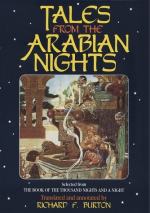[FN#196] Here a little abbreviation has been found necessary: “of no avail is a twice-told tale.”
[FN#197] The nearest approach in Eastern tales to Western hysterics.
[FN#198] A tent-pitcher, body servant, etc. See vol. vii. 4. The word is still popular in Persia.
[FN#199] The amount of eating and drinking in this tale is phenomenal; but, I repeat, Arabs enjoy reading of “meat and drink” almost as much as Englishmen.
[FN#200] Arab writers always insist upon the symptom of rage which distinguishes the felines from the canines; but they do not believe that the end of the tail has a sting.
[FN#201] The circular leather which acts alternately provision bag and table-cloth. See vols. i. 178; v. 8; viii. 269, and ix. 141.
[FN#202] He refused because he suspected some trick and would not be on terms of bread and salt with the stranger.
[FN#203] The story contains excellent material, but the writer or the copier has “scamped” it in two crucial points, the meeting of the bereaved Sultan and his wife (Night ccclxxvii.) and the finale where we miss the pathetic conclusions of the Mac. and Bresl. Edits. Also a comparison of this hurried denouement with the artistic tableau of “King Omar bin al-Nu’uman,” where all the actors are mustered upon the stage before the curtain falls, measures the difference between this Ms. and the printed texts, showing the superior polish and finish of the latter.
[FN#204] Vol. iii. pp. 386-97, where it follows immediately the last story. Scott (Story of the Avaricious Cauzee and his Wife, vi. 112) has translated it after his own fashion, excising half and supplying it out of his own invention; and Gauttier has followed suit in the Histoire du Cadi avare et de sa Femme, vi. 254.
[FN#205] Tarabulus and Atrabulus are Arabisations of Tripolis (hod. Tripoli) the well-known port-town north of Bayrut; founded by the Phoenicians, rose to fame under the Seleucidae, and was made splendid by the Romans. See Socin’s “Baedeker,” p. 509.
[FN#206] i.e. the Kazi’s court-house
[FN#207] Arab. “Buksumah” = “hard bread” (Americanice).
[FN#208] Arab. “Sufrah umm jalajil.” Lit. an eating-cloth with little bells, like those hung to a camel, or metal plates as on the rim of a tambourine.
[FN#209] The Kursi here = the stool upon which the “Siniyah” or tray of tinned copper is placed, the former serving as a table. These stools, some 15 inches high and of wood inlaid with bone, tortoise-shell or mother-of-pearl, are now common in England, where one often sees children using them as seats. The two (Kursi and Siniyah) compose the Sufrah, when the word is used in the sense of our “dinner-table.” Lane (M.E. chapt. v.) gives an illustration of both articles.
[FN#210] Arab. “Jaridah,” a palm-frond stripped of its leaves (Supplemental vol. i. 203), hence the “Jarid” used as a javelin; see vol. vi. 263.




